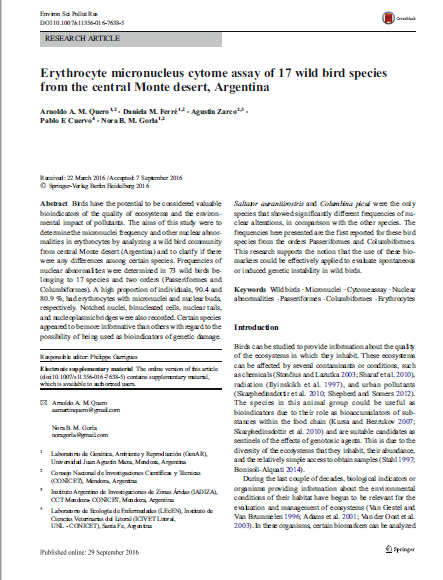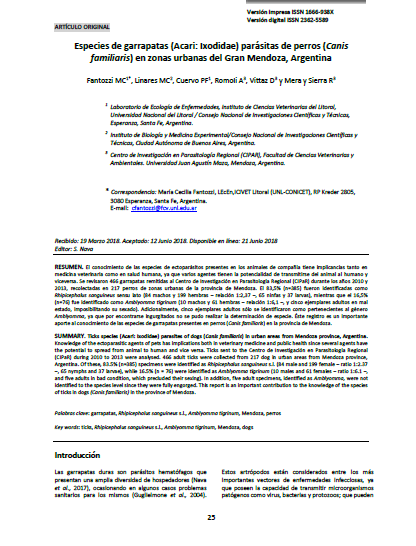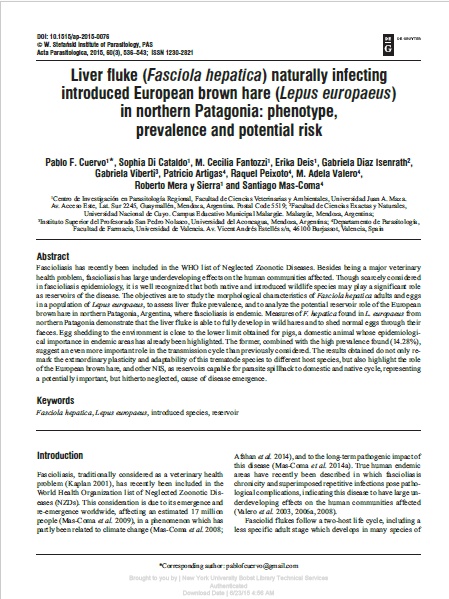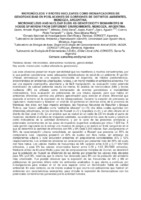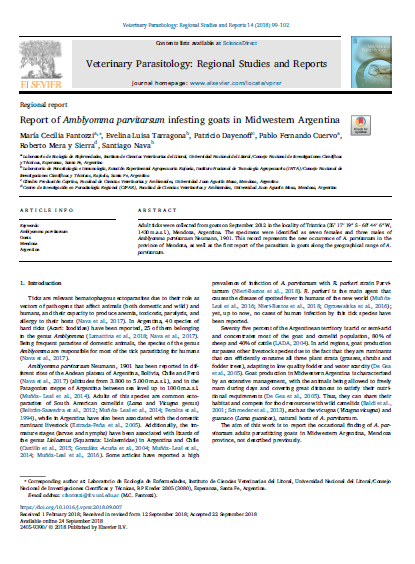Browsing by Author "Cuervo, Pablo Fernando"
Now showing items 1-5 of 5
-
Erythrocyte micronucleus cytome assay of 17 wild bird species from the central Monte desert, Argentina.
Quero, Arnoldo Ängel Martín; Ferré, Daniela Marisol; Zarco, Agustín; Cuervo, Pablo Fernando; Gorla, Nora Bibiana María (Editorial Environmental Science and Pollution Research, 2016-09-29)Birds have the potential to be considered valuable bioindicators of the quality of ecosystems and the environmental impact of pollutants. The aims of this study were to determine the micronuclei frequency and other nuclear abnormalities in erythrocytes by analyzing a wild bird community from central Monte desert (Argentina) and to clarify if there were any differences among certain species. Frequencies of nuclear abnormalities were determined in 73 wild birds belonging to 17 species and two orders (Passeriformes and Columbiformes). A high proportion of individuals, 90.4 and 80.9 %, had erythrocytes ... -
Especies de garrapatas (Acari: Ixodidae) parásitas de perros (Canis familiaris) en zonas urbanas del Gran Mendoza, Argentina.
Fantozzi, María Cecilia; Linares, María Cielo; Cuervo, Pablo Fernando; Romoli, Andrés; Vittaz, Diego; Mera y Sierra, Roberto (Comité editorial Revista FAVE – Sección Ciencias Veterinarias, 2018-06-21)El conocimiento de las especies de ectoparásitos presentes en los animales de compañía tiene implicancias tanto en medicina veterinaria como en salud humana, ya que varios agentes tienen la potencialidad de transmitirse del animal al humano y viceversa. Se revisaron 466 garrapatas remitidas al Centro de Investigación en Parasitología Regional (CIPaR) durante los años 2010 y 2013, recolectadas en 217 perros de zonas urbanas de la provincia de Mendoza. El 83,5% (n=385) fueron identificadas como Rhipicephalus sanguineus sensu lato (84 machos y 199 hembras – relación 1:2,37 –, 65 ninfas y 37 larvas), ... -
Liver fluke (Fasciola hepatica) naturally infecting introduced European brown hare (Lepus europaeus) in northern Patagonia: phenotype, prevalence and potential risk
Cuervo, Pablo Fernando; Di Cataldo, Sophia; Fantozzi, María Cecilia; Deis, Erika; Diaz Isenrath, Gabriela; Viberti, Gabriela; Artigas, Patricio; Peixoto, Raquel; Valero, María Adela; Mera y Sierra, Roberto; Mas-Coma, Santiago (Comité editorial Acta Parasitologica, 2015-06-23)Fascioliasis has recently been included in the WHO list of Neglected Zoonotic Diseases. Besides being a major veterinary health problem, fascioliasis has large underdeveloping effects on the human communities affected. Though scarcely considered in fascioliasis epidemiology, it is well recognized that both native and introduced wildlife species may play a significant role as reservoirs of the disease. The objectives are to study the morphological characteristics of Fasciola hepatica adults and eggs in a population of Lepus europaeus, to assess liver fluke prevalence, and to analyze the potential ... -
Micronúcleos y brotes nucleares como biomarcadores de genotoxicidad en poblaciones de gorriones de distintos ambientes, Mendoza, Argentina
Quero, Martín; Méndez, Sofía; Juaire, Karim; Zarco, Agustín; Cuervo, Pablo Fernando; Gorla, Nora (2018)Las aves silvestres presentan mayor sensibilidad que los mamíferos a muchos contaminantes, por lo que podrían considerarse como adecuados bioindicadores de salud de un ambiente. -
Report of Amblyomma parvitarsum infesting goats in Midwestern Argentina
Fantozzi, María Cecilia; Tarragona, Evelina Luisa; Dayenoff, Patricio; Cuervo, Pablo Fernando; Mera y Sierra, Roberto; Nava, Santiago (Comité editorial Veterinary Parasitology, 2018-09-24)Adult ticks were collected from goats on September 2012 in the locality of Trintrica (35° 17′ 19″ S - 68° 44′ 6″ W, 1430 m.a.s.l.), Mendoza, Argentina. The specimens were identified as seven females and three males of Amblyomma parvitarsum Neumann, 1901. This record represents the new occurrence of A. parvitarsum in the province of Mendoza, as well as the first report of the parasitism in goats along the geographical range of A. parvitarsum.







